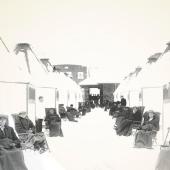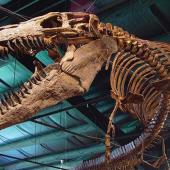Flying High
People have called the National Museum of World War II Aviation the best-kept secret in Colorado Springs, says museum president and CEO Bill Klaers. Visitors are finding it; the museum is listed as a top Springs attraction by TripAdvisor.
But it’s unknown by many in the community, he adds.
That could change with the opening this fall of the Kaija Raven Shook Aeronautical Pavilion. The new airplane display hangar will add 40,000 square feet to the 110,000-square-foot museum, which opened in 2012 with three hangars on a 21-acre campus at the Colorado Springs Airport. The new pavilion is the first phase of a capital development program; it would double in size under phase two of the program, and a third phase envisions an 86,000-square-foot Aviation Hall, which would house new exhibits, an events center, and an education center.
Education is the primary mission of the museum, which offers a K–12 STEM (science, technology, engineering, and math) program. "Education is huge in our eyes," Klaers says. That’s because the past, he says, can seem so distant—and not just to the kids. One confused teacher, he says, came in and asked not about World War Two, but World War Eleven.
The museum has been officially recognized by Congress as "America’s National World War II Aviation Museum." The planes in the museum typically are not roped off, so visitors can not only see pieces of history, but touch them as well. Most of the planes have been restored by Klaers’ Westpac Restorations, which is next door to the museum, and all are in flying condition, says museum spokesman John Henry.
"That’s a real delineating factor between museums," he says. "Many worthwhile museums, frequently they don’t undertake that expense." Most of the planes featured at the Pikes Peak Regional Airshow in September are from the museum.
Among the museum’s treasures, "the most iconic is the P-38 ‘White 33,’" Klaers says. That plane, with a known combat history, was retrieved from the jungles of New Guinea in the late 1990s and meticulously restored. And it turned out to have a Colorado Springs connection: Frank Royal, a World War II pilot who later settled in the Springs, visited WestPac while the aircraft was being restored and revealed that he had flown that actual plane. Royal was able to see the plane fully restored before he died in late 2016 at the age of 101.
It’s stories like Royal’s—stories of young men who took to the skies far from home, of families who sacrificed so much—that are at the heart of the museum, Klaers says. "It’s not just about the airplanes. The airplanes are only tools, teaching tools. The planes are wrapped around the story, and the story is what you’re trying to tell."
NATIONAL MUSEUM OF WORLD WAR II AVIATION
755 Aviation Way
Hours vary; to check schedule and costs, go to www.worldwariiaviation.org
PIKES PEAK REGIONAL AIR SHOW
Colorado Springs Airport
Sept. 21–22
For schedule and ticket information, go to www.pprairshow.org




